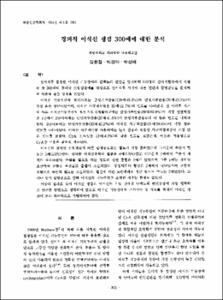KUMEL Repository
1. Journal Papers (연구논문)
1. School of Medicine (의과대학)
Dept. of Internal Medicine (내과학)
경피적 이식신 생검 300예에 대한 분석
- Keimyung Author(s)
- Kim, Hyun Chul; Park, Sung Bae
- Department
- Dept. of Internal Medicine (내과학)
- Journal Title
- 대한신장학회지
- Issued Date
- 1995
- Volume
- 14
- Issue
- 3
- Abstract
- It is a troublesome but significant problem to clarify the causes of allograft dysfunction in the management of kidney transplantation. The introduction of cyclosporine(CyA) has been a major advance in clinical transplantation, but its general use has introduced a new important clinical problem: nephrotoxicity. The clinical differentiation between nephrotoxicity and other causes of allograft dysfunction is not only difficult, but often impossible0"^. At the present time, allograft biopsy is the best way to differentiate among the various causes of graft dysfunction in patients treated with CyA23^ We have retrospectively reviewed 300 allograft biopsies to assess the causes of allograft dysfunction and proteinuria according to posttransplant period and also evaluated risks and benefits of allograft biopsies.
In our study, overall, acute (139 case '46.3%) and chronic rejection(70 case : 23.3%) were the two most common histologic diagnoses, 35(11.7%) had transplant glomerulonephritis. The major cause of graft dysfunction varied according to the post transplant period. Within 6 months, acute rejection (89:69.5%) was the most frequent diagnosis, whereas between 1 and 2 year, chronic rejection(20:41.6%) became the most frequent diagnosis over acute rejection. After 2 years, chronic rejection (33-45.2%) and transplant glomerulonephritis (21:28.8%) were the two most frequent. Among transplant glomerulonephritis, IgA nephropathy and focal glomerulos-
clerosis were the two most common diagnoses.
In our series, CyA nephrotoxicity accounted for only 4.3% of the cause of allograft dystunction at various time interval after transplantation. The relatively low incidence of CyA nephrotoxicity in our series can be explained by massive dose reduction in the initial and maintenance phase.
As in other series, microscopic and gross hematuria were our most common complications. Macroscopic hematuria occurred in 15 patients(5.0%). Clinically significant perirenal hematoma occurred in four patients(1.5%); one of these required surgical intervention. There were three(1.0%) bleeding complications requiring transfusion. One of which was successfully controlled by percutaneous embolization. Transient anuria due to blood clot obstruction was seen in two cases (0.9%). None of these complications led to loss of graft function.
In conclusion, the percutaneous allograft biopsy is a saft and invaluable tool in the evaluation and management of allograft dysfunction and significant proteinuria.
신이식후 발생한 이식신 기능장애와 단백뇨의 원인을 알기위해 170명의 신이식환자에서 시행 된 총 300예의 경피성 신침생검예를 대상으로 신이식후 시기에 따른 진단과 합병증둥을 분석하 여 다음과 같은 성적을 얻었다.
이식신 기능부전의 원인으로는 급성거부반응(139예:46.3%)와 만성거부반응(70예:23.3%)이 가장 혼한 원인이었으며, 이식신 사구체신염은 35예(11.7%)의 빈도를 나타냈다. 신 이식후 시기 에 따른 이식신기능부전의 원인으로 6개월이내에는 급성거부반응(89예:69.8%)이 가장 빈번하였 고 1년에서 2년사이에는 만성거부반응(20예:41.6%)이 급성거부반응보다 더 많은 빈도를 나타내 었다. 2년이후에는 만성거부반응(33예:45.2%)와 이식신 사구체신염(21예:28.8%)이 가장 많은 빈도를 나타내었다. 이식신 사구체신염 가운데에는 IgA 신중과 초점성 사구체경화중이 가장 많 은 빈도를 보였다. CyA 신독성은 13예(4.3%)의 낮은 빈도를 보였는데,이것은 저용량으로 CyA을 사용한 결과로 생각된다.
이식신의 경피성 신침생검에 따른 합병중으로는 혈뇨가 가장 혼하였는데 그가운데 육안적 혈 뇨는 5예(5.0%)였다. 심각한 이식신주위의 혈종은 4예(1.5%)였고 이가운데 1예에서 수술적 제 거가 필요하였다. 수혈을 필요로 하는 정도의 심한 출혈은 3예가 있었으며 그중 1예는 경피성 초선택적 신혈관 색전술로 출혈이 소실되었다. 동정맥투의 형성은 2예에서 나타났으며 보존적 요법으로 육안적 혈뇨는 소실되었다. 혈전에 의한 뇨관폐쇄로 생긴 일시적 무뇨는 2예있었다. 그 러나 상기 합병중으로 인해 이식신의 기능부전을 초래한 경우는 한예도 없었다.
이상의 결과로 보아 이식신 생검은 이식신의 기능 장애및 단백뇨의 원인규명에 가장 정확하 고 안전한 방법으로 생각되며 앞으로 이식신 기능장애의 조기진단 및 치료를 위해서 이식신 생 검이 보다 적극적으로 시행되어야 겠다.
- Alternative Title
- Analysis of 300 Percutaneous Renal Allograft Biopsies
- Publisher
- School of Medicine
- Citation
- 김현철 et al. (1995). 경피적 이식신 생검 300예에 대한 분석. 대한신장학회지, 14(3), 303–309.
- Type
- Article
- ISSN
- 1225-0015
- Appears in Collections:
- 1. School of Medicine (의과대학) > Dept. of Internal Medicine (내과학)
- 파일 목록
-
-
Download
 oak-bbb-02389.pdf
기타 데이터 / 439.06 kB / Adobe PDF
oak-bbb-02389.pdf
기타 데이터 / 439.06 kB / Adobe PDF
-
Items in Repository are protected by copyright, with all rights reserved, unless otherwise indicated.